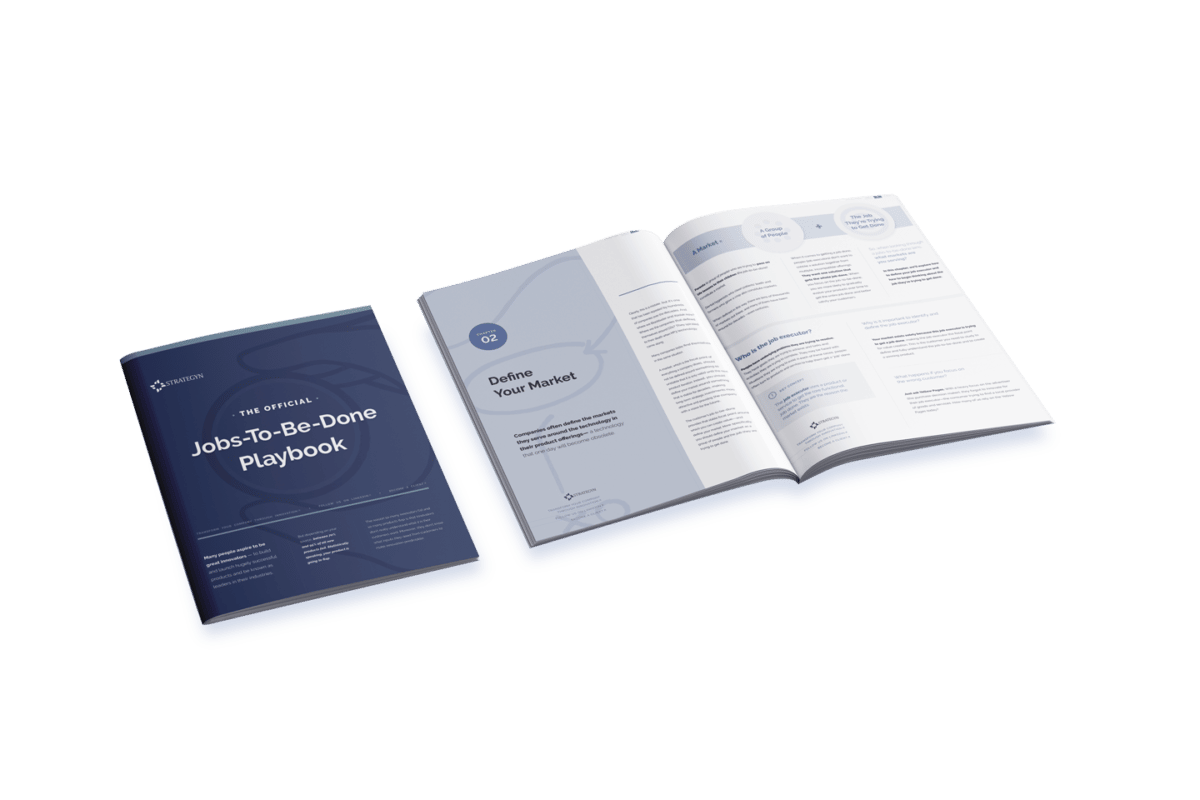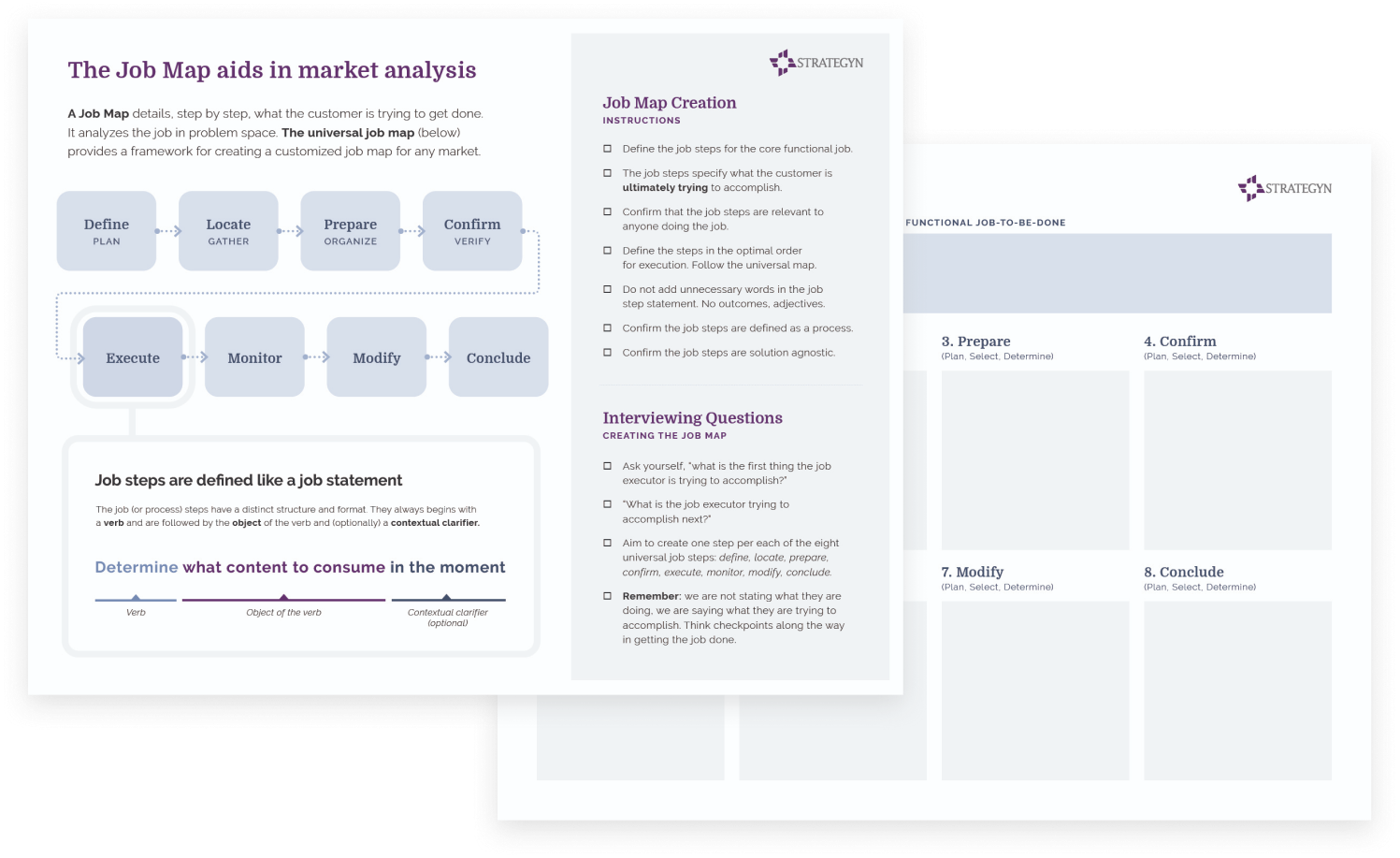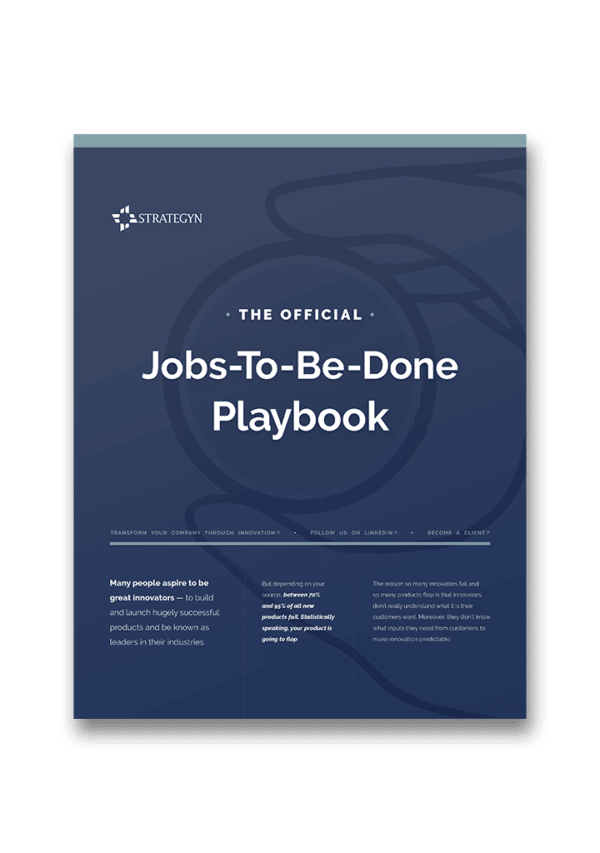Traditionally, they had viewed this offering mostly as a vehicle to aid in the purchase of software upgrades. But IT budgets were facing increased scrutiny. Their renewals were declining. And Microsoft saw a lot of potential revenue at risk.
As one tech reporter observed, “There appears to be some disconnect between how Microsoft wants to sell its software and how businesses want to buy.”
They were under increasing pressure to give customers more reasons to renew. Fast.
So they created a job map.
Microsoft Director Dave Wascha explained that when they took a hard look at what their customers were actually trying to get done,
“…we realized that we were only really engaging with the customer in one tiny piece of their job—the purchase of the software. But this was just part of a much bigger challenge that they faced. We were not engaging with them in many of these other areas that were very important to them and where they were very dissatisfied.”
Creating a job map is revelatory for many brands.

Download your free copy of The Official Jobs-to-be-Done Playbook.
The job map is a visual depiction of the job your customers are trying to get done that allows you to deconstruct each and every step of the process. It clarifies and visualizes what your customers are trying to get done as specific process steps, capturing all of their needs along the way.
It’s the job map that turns the fundamentals of Jobs Theory into a reliable, repeatable innovation practice. Companies often realize they’re addressing less of the customer’s job than they could be, which allows them to systematically identify opportunities for growth.
The job executor uses a product or service to get the core functional job done. They are the reason the market exists.
Creating a job map helps you to:
DEFINE VISION AND DIRECTION.
The completed job map lays out a long-term strategy and vision for your organization— which is to devise a solution that gets the entire job done on a single platform or with a single offering.
DISCOVER OPPORTUNITIES.
It is often the case that competitive insights and innovative ideas can come from analyzing the job map, as it points out holes and deficiencies in existing solutions.
GUIDE CUSTOMER NEEDS GATHERING.
The individual or group who helps the job executor install, set up, store, transport, maintain, repair, clean, upgrade, and/or dispose of the product.
This chapter of our Jobs-to-be-Done Playbook outlines what goes into a job map—and what doesn’t. We’ll also cover how to get started building your own, so you can figure out exactly what value to add to your own products or services.
Just like Microsoft did to double their year-over-year Software Assurance revenue.
It’s not a process map.
It’s not a customer journey or customer experience map.
It does not does not describe the journey the customer goes through to buy, receive, set-up, use, upgrade, clean or maintain a product.
If you are focusing on the purchase process or the customer experience, you are not focused on documenting the customer’s core functional job.
A job map also does not show what the customer is doing (a solution view).
For example, when an anesthesiologist checks a monitor during a surgical procedure, it’s not just for fun. The point is NOT just to look at the monitor. It’s a means to an end.
Instead, a good job map describes what the customer is trying to get done (a needs view)—independent of the solution they are using.
For the anesthesiologist, the job may be detecting a change in patient vital signs. Whether your customers are in the USA, India or South Africa, or whether they are using any number of competing products, a single job map will describe what each and every customer is trying to accomplish. The anesthesiologist’s job doesn’t change just because she’s in another part of the world using a different kind of monitor.
Your completed job map represents your customer’s ideal process flow for their job. It depicts all the steps to complete the job in the ideal order for efficient execution.
We’ve analyzed hundreds—if not, thousands—of customer jobs over the years. We’ve mapped jobs for products and for services. We’ve mapped jobs for durable and consumable goods, chemicals, software, professional and consumer services, and many other industries.
Your goal is to uncover what your customers are trying to do during each of these steps—then look for opportunities to help get each step done better (faster, more cheaply, and/or with more output/throughput).
Let’s take a deeper look at each process step and how to uncover key insights for each.
At each job step ask these questions when interviewing your customers.
Many jobs include an element of planning. This is the step in which your customers:
You should be looking for ways to help your customers understand their objectives, simplify the resource-planning process, and reduce the amount of planning needed.
Let’s take a look at the job of losing weight. Few people go into this job without a bit of planning —how much weight they want to lose, what sorts of foods they’ll eat and which they’ll avoid, how to incorporate exercise, etc.
Weight Watchers offers a solid example of helping customers to get this step of their job done better. By offering a system that doesn’t require calorie counting, the brand helps to streamline the diet planning process. The brand also offers a variety of recipes that fit easily into their points-based program. People looking to lose weight can worry less about what they’re eating by following the Weight Watchers program.
Your customer often needs certain inputs to get a job done—these inputs can be tangible or intangible step in which your customers:
TANGIBLE INPUTS
INTANGIBLE INPUTS
The goal of understanding this step of the job map is to find opportunities to streamline the gathering process. For example, your solution might make it easier to bring required components together—or eliminate the need for some components altogether.
Consider meal kit solutions like Hello Fresh and Blue Apron. These kits provide nearly all of the ingredients you need to streamline the process of preparing a meal. Instead of spending time going to the store and shopping for all of your ingredients, they come pre-packaged and pre-portioned—and they’re delivered right to your door. The kits also list out each of the tools you’ll need to prepare the meal, which makes the “location” step much easier for the cook..
Abbott Medical Optics (AMO) is a leading provider of lenses, insertion systems, laser vision correction systems, and other devices for cataract and refractive surgical procedures. When AMO examined this step of the job map, they realized it was a big problem for their customers if they did not have the right lenses on hand for a cataract surgical case. Their solution was to make it easier to get the lenses when customers needed them by creating an advanced schedule-planning and inventory management software module that facilitates accurate and timely replenishment.
Once your customer has inputs for a job in hand, they often have to set up and organize these inputs. It may also be necessary to prepare a working surface or some other aspect of the physical environment.
At this stage, you want to look at ways to make setup less difficult for your customer. Consider how you could:
In 2001, the Robert Bosch Tool Company decided to enter the circular saw market, which was considered mature and commoditized—nothing much had changed about circular saws in years.
Bosch wanted to develop a premium brand circular saw that would allow them to compete against the likes of DeWalt and Makita. The goal was to create an offering that:
It was time to be innovative.
At this step in completing the job, your customer wants to make sure everything is in place for a successful outcome.
THIS INCLUDES CONFIRMING THINGS LIKE:
All of this confirmation might seem like overkill after three steps of preparation—but it is especially critical for jobs in which a delay in execution might risk a customer’s money, time, or safety.
For example, the surgical nurse must confirm the readiness of:
There are a couple of ways you can differentiate your solution at this step of the job map:
For example, Oracle’s ProfitLogic merchandising optimization software removes the responsibility from the merchandiser for confirming the optimal timing and level of markdowns by analyzing thousands of different demand scenarios at the individual product level and recommending the scenario for each product that is likely to yield the highest profit.
It’s time to actually DO the job—and your customer wants to get it right. Whether they’re feeding cattle or surgically removing cataracts, customers consider the execution step the most important part of the job. It’s also the most visible step (and no one wants to make mistakes in the limelight).
With all of this in mind, customers are especially concerned about avoiding problems and delays at this stage of the game—as well as achieving optimal results.
Your best opportunity to add value at this step is to provide customers with real-time feedback or to automatically correct execution problems. You can also come up with ways to keep performance consistent in different contexts.
Kimberly-Clark’s Patient Warming System is a good example of value added in this way. The system relies on a control unit that automatically circulates heated water through thermal pads placed on the patient to avoid temperature spikes during surgery. The system can maintain normal patient temperature with only 20% of the patient body covered, which means the device performs consistently and efficiently in a variety of complex surgical procedures.
Abbott Medical Optics (AMO) is a leading provider of lenses, insertion systems, laser vision correction systems, and other devices for cataract and refractive surgical procedures. When AMO examined this step of the job map, they realized it was a big problem for their customers if they did not have the right lenses on hand for a cataract surgical case. Their solution was to make it easier to get the lenses when customers needed them by creating an advanced schedule-planning and inventory management software module that facilitates accurate and timely replenishment.
Once the execution step is underway, many jobs also require some sort of monitoring to make sure things are going well. In this case, customers need to keep an eye on results during execution. This helps them determine whether things are on track—or whether they have to make some adjustments. A digital marketer needs to monitor campaign performance to ensure return on ad spend, for example.
For some jobs, customers must also monitor environmental factors to see if and when they might need to make some changes.
Some of this monitoring is passive and doesn’t require the customer to put in much effort (like the way a pacemaker monitors heartbeats).
To solve customer needs at the monitoring stage, figure out if your solution can call attention to problems or relevant changes in the environment. This is particularly important for jobs where it’s critical to get execution correct—like when operating on a patient or executing on an investment strategy.
You can also offer new value by linking your monitoring innovations with improved job execution or by providing diagnostic feedback.
Consider how fitness tools and apps like the Apple Watch, Fitbit and MyFitnessPal help users monitor their physical activity and diet. They offer real-time monitoring on heart rate, steps per minute, calorie burn, calorie intake, run distance and pace, etc. to help users improve results of their diet and exercise efforts. Customers can set reminders to move their bodies at certain intervals, and these tools even integrate with scales to monitor weight.
Executing the job doesn’t always go perfectly. If monitoring indicates something needs to change, your customer needs to look at performing updates, adjustments or maintenance.
The digital marketer monitoring an ad campaign might notice it’s not producing the intended results—and therefore need to make adjustments to the messaging, creative, or target audience, for example.
Searching for the right adjustment can be time-consuming and expensive. Your innovation should consider ways to help customers get execution back on track when there are problems—and preventing problems in the first place.
At the modification step, you can innovate by helping customers:
Many software programs perform well at supporting this step. Microsoft, for example, assists customers with the job of modifying their computer to protect against security threats. Automatic updates of its operating system remove the hassle of determining which updates are necessary, finding them, and ensuring that fixes are compatible with various elements of the operating system.
It’s obvious when you finish up a simple job brushing your teeth. But more complex jobs often have some steps related to wrapping things up. The painter needs to remove painter’s tape, clean up and store/dispose of unused supplies, and return the furniture to its proper positions.
Customers often think of concluding steps as a bit of a pain—because the core job has already been completed.
There are a couple of ways to help customers better finish their jobs.
3M’s Coban Self-Adherent Wrap, for example, offers a convenient way for medical personnel to secure wound dressings at the end of treatment, because it is made of a material that stretches and adheres only to itself. This self-adherence property makes the wrap easy to remove, because it doesn’t stick to patient skin or the wound. 3M designed the product in such a way that putting on the wrap anticipates the act of taking it off.
To further illustrate, let’s follow a customer’s steps through the job map for a single job: painting a room.
You may be tempted to write the process for how a job executor gets the job done. Anytime you think about “how,” immediately consider “why” instead.
A typical job map will include between 10 to 20 steps (there are usually multiple planning, gathering, and executing steps, for example).
List the steps in the order that would be the most ideal for efficient execution (not necessarily the same as the order the customer is completing them now).
Write steps in proper format: [verb] + [object] + [contextual clarifier].
Do not include any reference to a particular solution in your job map.
Now you understand what a job map is, how to build one, and how to use it.
But the best job maps include customer insights gleaned from interviews.. Once you’ve defined your job-to-be-done, interviewing these job executors helps to validate your other internal and external research and refine your job map.

If you’re interested in learning more about how to recruit, screen, and interview customers as part of the job mapping process, check out our MyStrategyn Courses.
One team, for example, who thought its tax products were being used for the job of “prepare taxes” was surprised to learn the real job was to “formulate and execute a tax strategy.”
Download the job map template and begin building your job map today.

WHAT’S NEXT?
Great work!
You just built your customer’s job map.
You and your team now have the ability to map out each step of your customer’s job-to-be-done so you can add more value every step of the way.
Congratulations on another milestone in your innovation journey!
In Chapter 4, we will be showing you how the job map aligns the entire organization around a common understanding of the customer, and all the ways the job map will help you in your role.
